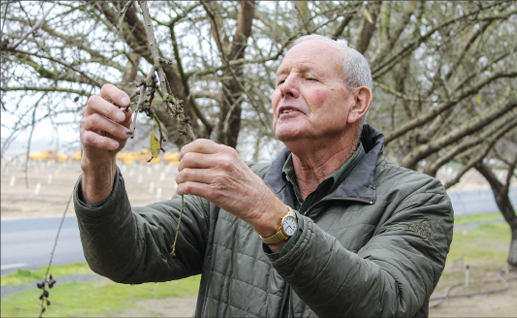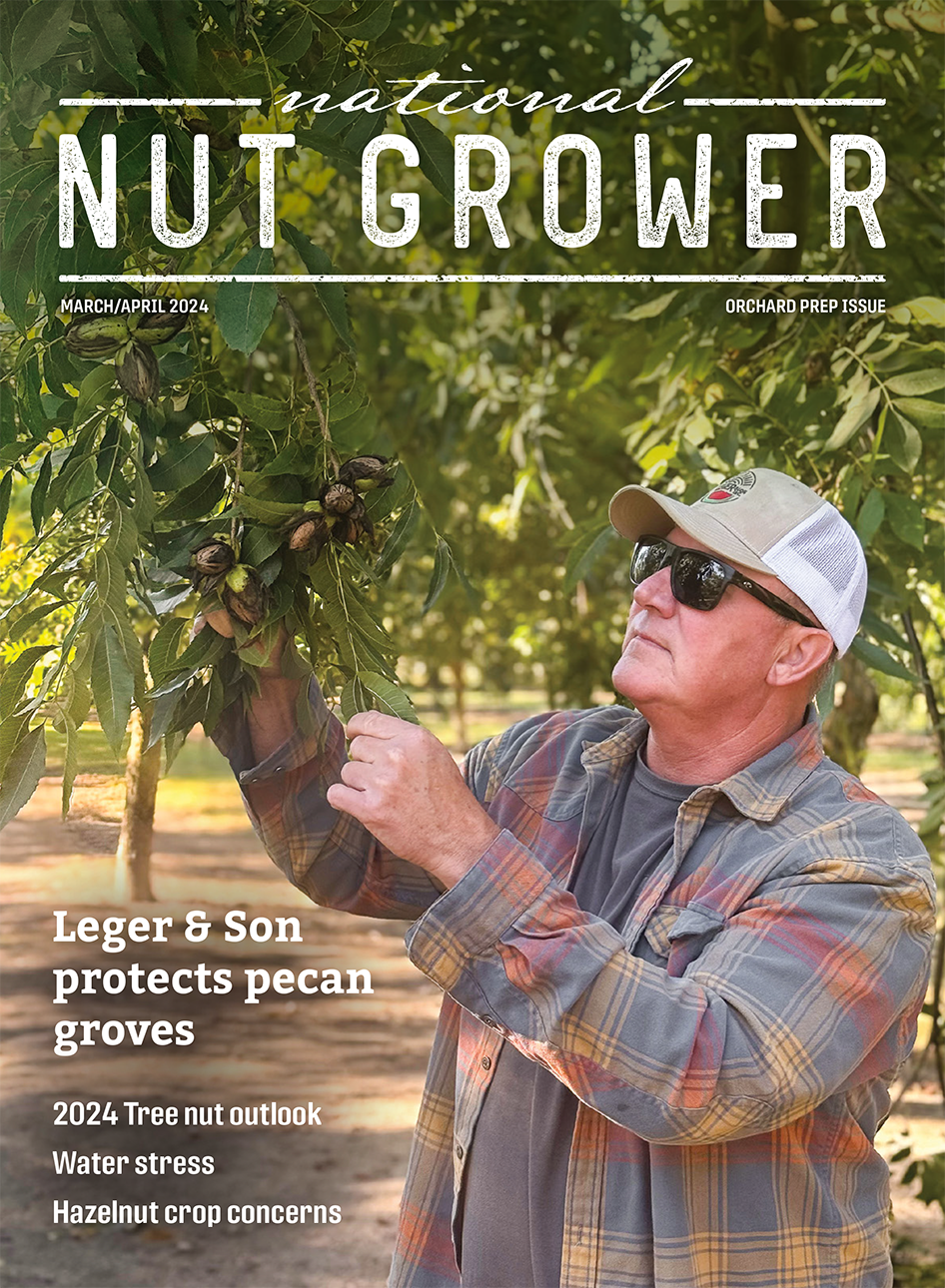
Jan 11, 2022California trees are chilling out, which is good news
Fruit and nut trees up and down the Central Valley are chilling out this winter – which is exactly what their farmers want to see.
Nick Gatzman, who grows and packs almonds in Manteca with his father-in-law, Dave Phippen, said the winter of 2021-2022 looks as though it will be a good one for cold weather.
“I think we’re going to have sufficient chill hours,” Gatzman said. “We’re pretty similar to the last five years, with the exception of last year.” At this point, 2020 had a couple hundred more hours, he added.
Indeed, according to the chilling-hour calculators at the University of California, Davis, Fruit and Nut Research Center, Manteca had seen 497 chill hours and 480 hours between Nov. 1 and Jan. 6. At the same time last year, the city had registered 734 hours. The previous four years registered 523 to 592 hours each.
Chill hours are times when temperatures are between 32 and 45 degrees Fahrenheit. This keeps the tree dormant for the winter. A warm winter with insufficient chill hours can result in a late or uneven bloom and, eventually, lower crop yields.
There may be no such worries this year, said Katherine Jarvis-Shean, a University of California Cooperative Extension orchard advisor in Yolo and Sacramento counties.
“We’re in a really great position with winter chill accumulation this winter,” Jarvis-Shean said. “We’re having the highest chill that we’ve had in the last seven years – even cooler than the 2016-2017 winter, which was our last pretty cold winter.”
Jarvis-Shean noted that almonds have largely surpassed their needed chill requirement, “but for cherries, pistachios, walnuts – we’re still in the middle of winter as far as their counting is concerned. So everything looks good, but I would stay tuned.”
Phippen noted with optimism that his neighborhood has been foggy this winter, which is an added chilling benefit.
“The fog keeps the sunshine out of the orchard for a period in the morning, and so you get extra chill hours besides the evening,” Phippen said, explaining that the late-October atmospheric river storm was a turning point.
“We had a lot of fog following that, and I believe that’s right in the realm of the chill hours,” Phippen said.
In the Sutter County town of Meridian, walnut farmer Brian Fedora is happy with what he’s seen so far.
“I can definitely tell you that this is the coldest winter we’ve had in some time,” Fedora said. “Our walnut trees in the Sacramento Valley are very much asleep, logging those hours, and that’s a great thing.” Chandler and Howard walnut trees need about 1,015 hours of chill time, he added.
“I’m excited because we haven’t had good chill hours and good sub-moisture for a couple years,” Fedora said. “We also haven’t had great Chandler production. With these temperatures and this moisture, to me, if you’re going to predict, it should be a very, very good year for Chandlers.”
Cling-peach growers also are watching the weather.
“We’ve closed a lot of our deficit from where we were a year ago, but we still have a few more to go,” said Rich Hudgins, chief executive of the California Canning Peach Association. “Our goal is to hit 800 hours between Nov. 1 and the end of February.”
Hudgins tracks chill hours in Verona, Davis, Modesto and Parlier. As of Jan. 3, he said, all except Davis were running behind their 2020-2021 levels.
“You want the tree to be in a period of dormancy before bloom so that it’s able to generate a crop at its full potential for the coming year,” Hudgins said. Insufficient chill time leads to an uneven bloom, “and then your crop is less than it could have been as a result,” Hudgins said.
Cold weather is also a citrus grower’s friend, up to a point.
“I know we’ve had some colder temperatures, and a lot of people are concerned about subfreezing temperatures,” said Casey Creamer, president of California Citrus Mutual in Exeter. “We actually really like that. We’re always concerned about a hard freeze, but colder weather – between 28 and 32-33 (degrees) – is actually really good for the trees.”
Creamer said winter dormancy helps to “color up the crop and preserve the quality that’s there, and allows us to have a really good product throughout the year.”
Citrus growers, especially in the Central Valley, are moving into peak-production season. Citrus is picked according to market demand, Creamer said, likening the presence of cold weather to the difference between storing fruit in the refrigerator and keeping it on the kitchen counter. When the quality is there, “we can pick to the market,” Creamer said. “Having that good, cold weather allows us to hold the quality a little bit longer.”
The point of concern for citrus is when temperatures drop below 28 degrees for multiple hours, Creamer said. Wind machines are one means of fighting such cold.
“If there’s a good inversion – several degrees warmer weather above the trees –those wind machines do a real good job of grabbing that warmer air and pushing it through the grove,” Creamer said. Irrigating the trees helps as well, as the water can help keep the groves out of the danger zone, he added.
Creamer said Citrus Mutual maintains weather stations and a staff meteorologist to help growers make decisions.
For cling peach and nut growers, a point of concern is cold weather at bloom time, which is mid-February for almonds and mid-March for peaches.
“At bloom time, anything below freezing is a problem, but if we’re in the 40-degree range, that’s fine,” Hudgins said. “Before the blossoms begin to emerge from the jacket, it’s a nonissue.”
Fedora said the same for his walnut trees.
“Once the trees are dormant, we don’t worry too much,” Fedora said. “They can take the frost. In the springtime, once the tree begins to move sap into the limbs, that’s when we can’t take it. That sap will freeze, and that’s where you’ll get the frost damage.”
Then there’s warmer winter weather, which can cancel out chill hours. A UC Davis chill-portion calculator subtracts chill units for temperatures above 60 degrees, and neither adds nor subtracts chill units for each hour the temperature is between 54 and 60 degrees.
Jarvis-Shean said research points to chill portions as being a more accurate measurement.
“There have been some years recently when we’ve had warm spells in the middle of winter, which can subtract from chill accumulation within the tree,” Jarvis-Shean said. “We’ve had some surprises in the spring, if you’re only counting by chill hours, because the trees have behaved like they didn’t get enough chill even though the chill-hours way of counting said that they did.”
Phippen said he doesn’t want to see any “warm January afternoons” on the way to bloom season.
“If, today, it gets to 55 or 60 degrees, it’s exciting that tree again,” Phippen said. “That’s when you get bud swell and all that. Ideally, we’d like just to stay chilled all the way till bloom.”
– Kevin Hecteman, California Farm Bureau Federation







